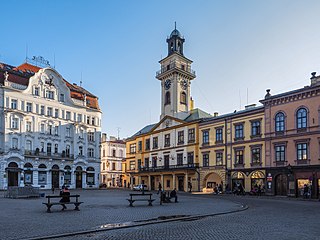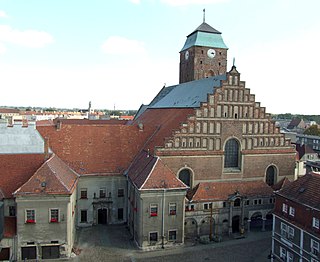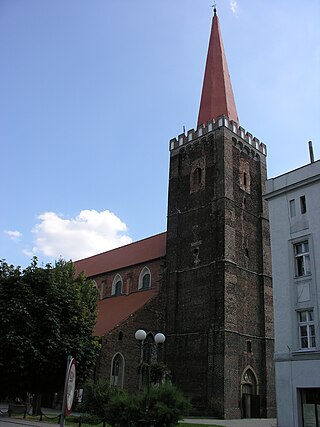
Świdnica is a city on the Bystrzyca River in south-western Poland in the Lower Silesian Voivodeship. As of 2021, it has a population of 55,413 inhabitants. It is the seat of Świdnica County, and also of the smaller district of Gmina Świdnica. It is the seventh largest city of the Lower Silesian Voivodeship. Świdnica became part of the Wałbrzych agglomeration on 23 January 2014.

Cieszyn is a border town in southern Poland on the east bank of the Olza River, and the administrative seat of Cieszyn County, Silesian Voivodeship. The town has 33,500 inhabitants, and lies opposite Český Těšín in the Czech Republic. Both towns belong to the historical region of Cieszyn Silesia, and formerly constituted the capital of the Duchy of Cieszyn as a single town.

Brzeg is a town in southwestern Poland with 34,778 inhabitants and the capital of Brzeg County. It is situated in Silesia in the Opole Voivodeship on the left bank of the Oder river.

Brzeg Dolny is a town in Wołów County, Lower Silesian Voivodeship in south-western Poland. It is located 31 km (19 mi) north-west of Wrocław on the Oder River, and is the site of a large chemical plant complex, PCC Rokita SA. As of December 2021, the town has a population of 12,395. It is part of the Wrocław metropolitan area.

St. Anne's Church is a church in the historic center of Warsaw, Poland, adjacent to the Castle Square, at Krakowskie Przedmieście 68. It is one of Poland's most notable churches with a Neoclassical facade. The church ranks among Warsaw's oldest buildings. Over time, it has seen many reconstructions, resulting in its present-day appearance, unchanged since 1788. Currently it is the main church parish of the academic community in Warsaw.
Strzelniki is a village in the administrative district of Gmina Lewin Brzeski, within Brzeg County, Opole Voivodeship, in south-western Poland. It lies approximately 9 kilometres (6 mi) north-west of Lewin Brzeski, 8 km (5 mi) south-east of Brzeg, and 32 km (20 mi) north-west of the regional capital Opole.

Mannerist architecture and sculpture in Poland dominated between 1550 and 1650, when it was finally replaced with baroque. The style includes various mannerist traditions, which are closely related with ethnic and religious diversity of the country, as well as with its economic and political situation at that time. The mannerist complex of Kalwaria Zebrzydowska and mannerist City of Zamość are UNESCO World Heritage Sites.

Brzeg Castle is located in Brzeg, Opole Voivodeship, within the Polish part of the Silesia region. Now a museum, the structures includes the Piast dynasty mausoleum.

Brzeg Town Hall is a Renaissance building designed by Bernard Niuron built between 1569 and 1577. It is considered to be one of the most important Renaissance monuments in Poland. In addition to its role as the seat of the municipal government of Brzeg, the building houses several other institutions.

Saints Peter and Paul Church in Brzeg, Poland, is a historic Gothic Franciscan basilica built in the thirteenth century.

Saints Peter and Paul Church in Strzegom, Poland, is a historic brick, Gothic minor basilica, located in Strzegom as part of the Diocese of Świdnica. Formerly, the basilica belonged to the Sovereign Military Order of Malta. Since 2002, the church serves as a minor basilica. It is the most prized heritage site of the town and is one of the largest churches in Lower Silesia. An example of Lower Silesian Gothic architecture. the church is enriched with artisanal handicraft, mainly from the fourteenth and fifteenth-century.

St. Anthony of Padua Church in Strzelniki, Poland, is a historic Renaissance fourteenth-century church. St. Anthony of Padua's Church was first mentioned in 1376. The present church was built in 1688, with the 1853 renovation restructuring its oval-cut windows. During renovations that took place in 1958, Medieval polychromes were discovered, that were later uncovered and exhibited between 1966 and 1979. The polychromes cover the entire interior of the church.

Assumption of the Blessed Virgin Mary Church in Żagań, Poland, is a Gothic church built between the fourteenth and second-half of the fifteenth century. The church is part of the Roman Catholic Diocese of Zielona Góra-Gorzów. It is listed as a Historic Monument of Poland.

Holy Cross Church in Ligota Górna, Poland, is a wooden church built in 1787. The church, a chapel of ease serves the Roman Catholic and the Evangelical-Augsburg Church.

St. Hyacinth's Church in Wierzbica Górna, Poland, is a wooden church built in 1722. The church belongs to St. Hyacinth Parish in Wierzbica Górna, in the Namysłów-South Deanery of the Roman Catholic Archdiocese of Wrocław. Since April 18, 1964 the church was registered on the Register of Objects of Cultural Heritage for the Opole Voivodeship, with the registration number of 818/64.

St. Brice's Church in Gościęcin, Poland, is a historic, wooden shrine belonging to the Parish of the Assumption of the Holy Virgin Mary in Gościęcin.

St. Michael's Church in Grodków, Poland, is a Gothic parish church built in the thirteenth century. The church belongs to the Roman Catholic Diocese of Opole.

The Church of St. Dorothy in Trzcinica – is a Roman Catholic, gothic, wooden, filial church. It belongs to the Parish of the Transfiguration in Trzcinica. It is classified as an Object of Cultural Heritage. The church is located in the Podkarpacie Voivodeship, in the village of Trzcinica. The patron saint of the church is Saint Dorothea of Caesarea. There is a similar church located in nearby Bączal Dolny - St. Nicholas' Church.


















